![]()
![]()
![]()
Use LEFT and RIGHT arrow keys to navigate between flashcards;
Use UP and DOWN arrow keys to flip the card;
H to show hint;
A reads text to speech;
44 Cards in this Set
- Front
- Back
- 3rd side (hint)
|
Tendon |
Attaches muscle to bone |
|
|
|
|
|
|
|
|
Anatomical Position |
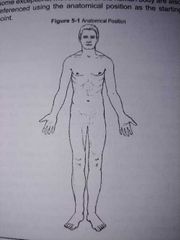
Position where the body is standing erect, thebfeet positioned hip width apart, with the toes pointing forward, arms hanging to the sides with palms facing forward. |
Mountain |
|
|
Medial Anatomical Location |
Positioned closer to the midline of the body |
|
|
|
Superior Anatomical Location |
Positioned closer to the head (away from the feet) |
|
|
|
Lateral Anatomical Location |
Positioned away from the midline or middle of the body |
|
|
|
Inferior Anatomical Location |
Away from the head (closer to the feet) |
|
|
|
Proximal Anatomical Location |
Positioned closer to the attached end of a limb or the center of the body
|
"In close proximity to"
|
|
|
Distal Anatomical Location |
Positioned away from the attached end of a limb or the center of the body
|
"a greater distance from"
|
|
|
Anterior Anatomical Location |
On or toward the front of the body |
|
|
|
Superfical Anatomical Location |
Closer to or on the surface of the body
|
|
|
|
Deep Anatomical Location |
Further beneath or away from the surface of the body
|
|
|
|
Posterior Anatomical Location |
On or toward the back of the body
|
|
|
|
3 planes of motion are?
|
Sagittal, Frontal, and Transverse Planes
|
|
|
|
Sagittal Plane of Motion |
Divides the body into right and left sides
|
|
|
|
Frontal Plane of Motion |
Divides the body into front and back (anterior and posterior)
|
|
|
|
Transverse Plane of Motion
|
Separates the body into upper and lower segments
|
horizontal plane
|
|
|
Axial Skeleton
|
Skeletal System that includes skull, spinal column, sturnum and ribs 80 bones |
|
|
|
Appendicular Skeleton
|
Skeletal system that includes upper and lower extremities, and shoulder and pelvic girdles 126 bones |
|
|
|
Articulation |
Junction between two adjacent bones (A Joint) |
|
|
|
3 types of bone cells:
|
Osteoclasts- bone destroying cells Osteoblasts- Bone building cells Osteocytes - mature bone cells that help regulate bone remodeling |
|
|
|
3 types of articulation: (Joints) |
Synarthrodial Amphiarthrodial Diathrodial |
|
|
|
Synarthrodial Joints
|
Immovable joints such as between suture joints of skull
|
|
|
|
Vertebral Column separated into 3 primary regions:
|
Cervical (skull and neck) Thoracic (connects to ribs) Lumbar (sacrum) |
|
|
|
Amphiarthrodial Joints
|
Slightly moveable such as disc between vertabra
|
|
|
|
Diathrodial joints
|
Freely moveable joints - most common n the body aka synovial joints |
|
|
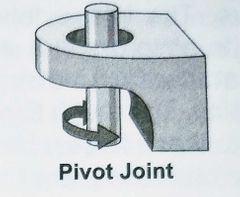
Pivot Joint |
Joint allows for rotation and is characterized by the ring of one bone fitting into or around the process of another. Example: elbow joint |
|
|
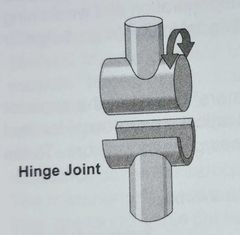
Hinge Joint |
Joint consists of a c-shaped surface of one bone rotating or swinging around the rounded surface of another Example: elbow and knee |
|
|
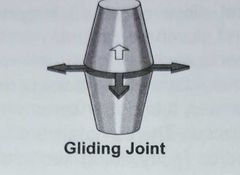
Gliding Joint |
Joint allows bones to glide in all directions over eachother.
Example: between carpals of hands and tarsals of feet |
|
|
|
Ligaments vs Tendons |
Ligaments connect bone to bone Tendons connects muscle to bone |
|
|
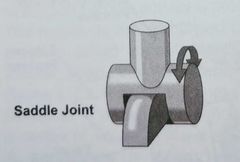
Saddle Joint |
Joint consists of the convex surface of one bone sitting in the concave surface of another. Example: joint of thumb |
|
|

Ellipsoid Joint |
Joint in which the oval shaped surface of one bone fits into the elongated or elliptical shaped cavity of another. Example: wrist, finger, toe joints |
|
|
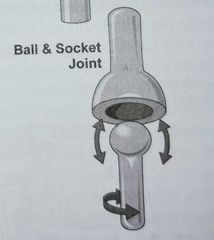
Ball and Socket Joint |
Joint in which the ball like head of one bone fits into the cup shaped socket of another. Example: shoulder joint |
|
|
|
Skeletal muscle consists of long cylindrical cells called ____________, each of which is comprised of thousands of smaller threadlike structures called ___________. |
Skeletal muscle consists of long cylindrical cells called muscle fibers each of which is comprised of thousands of smaller threadlike structures called myofibrils. |
|
|
|
3 classifications of Muscle tissue |
Cardiac (walls of heart) Smooth (lines internal organs) Skeletal (most abundant; voluntary) |
|
|
|
Sliding Filament Theory |
Suggests the when stimulated by the central nervous system, the small heads extending from the myosin filaments bind with the action filaments creating cross bridges. |
|
|
|
Myofibrils are comprised of even smaller contractual proteins called ___________; two types are _______, the thin filament and ______, the thick filament. |
Myofibrils are comprised of even smaller contractual proteins called myofilaments; two types are actin, the thin filament and myosin, the thick filament. |
|
|
|
Isotonic Action |
Action where the muscle shoetens and lengthens as force is generated against an external load |
|
|
|
Isometric Action |
Action where the muscle produces force, but there is no resulting movement and no change in muscle length |
I.A. |
|
|
Difference between Concentric and Eccentric Phases of Isotonic Action? |
Concentric is the shortening phase of isotonic muscle action. Eccentric is the lenghtening phase of isotonic muscle action |
|
|
|
Agonist Muscle functions |
Muscle(s) responsible for a specific movement |
|
|
|
Stabilizers Muscle functions |
Muscles that function to support and stabilize a body segment which enables agonists to effectively perform the desired movement. |
|
|
|
Synergist Muscle functions |
Other muscles that assist the agonist to perform a certain movement |
|
|
|
Antagonist Muscle functions |
Muscle(s) that work in direct opposition to the agonist |
|

